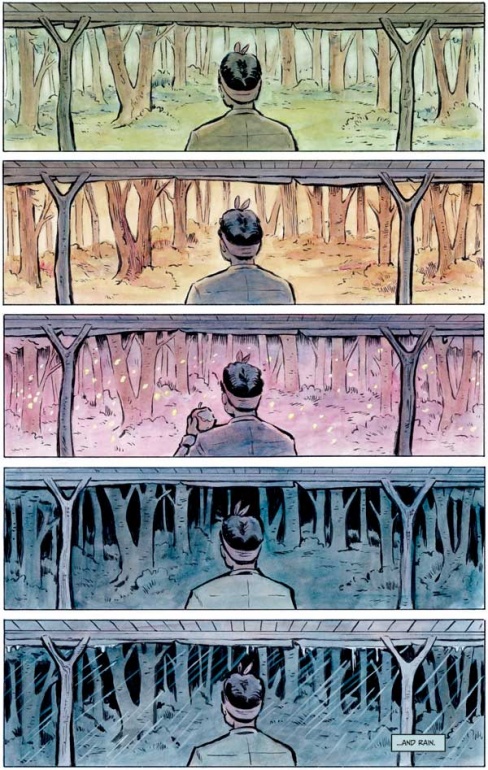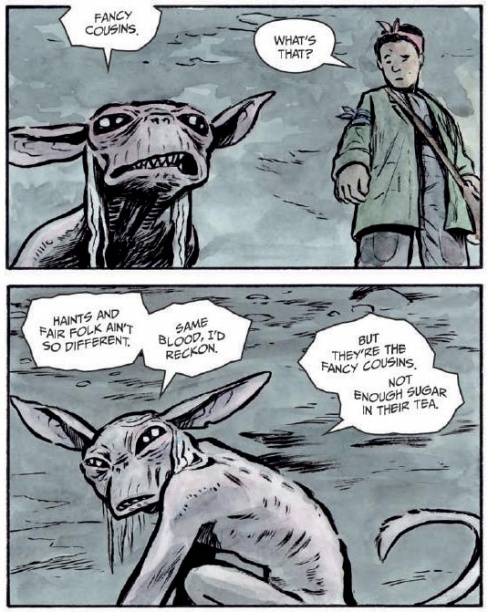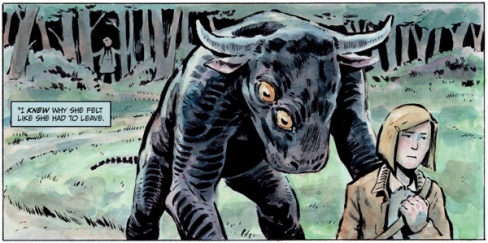There are a lot of comics out there, but some stand out head and shoulders above the pack. With “Don’t Miss This,” we want to spotlight those series we think need to be on your pull list. This week, we’re spotlighting “Tales of Harrow County: Fair Folk,” an enchanting tale that knows how to mix horror with comfort. Pull up, take a seat, and grab your grimoire.
Who’s This By?
As we’ll discuss below, the Harrow County universe has taken on many forms and been inhabited by many artists and creators. Regardless, the story is mostly the brainchild of Cullen Bunn, who you may know from his work at Oni Press (The Sixth Gunn, The Damned, The Tooth) and Marvel (Wolverine, Spider-Man: Season One, and Fear Itself: The Fearless). He also writes a middle school horror series, Crooked Hills, which is kind of like The Hardy Boys meets Goosebumps. More on this later.
At the artistic helm of “Tales of Harrow County: Fair Folk” stands Emily Schnall, a comics newcomer who nevertheless excels at the form. Her illustration includes everything from naturalistic scenes you’d expect to find in the Museum of Natural History to cryptids and horror beasts you’d find in…we guess the Museum of Unnatural History, or something. Whatever, her art rocks.

What’s This All About?
The world of Harrow County spans a number of series, including the original “Harrow County” and “Tales from Harrow County”, the spinoff series of which this iteration is a part (“Tales from Harrow County: Death’s Choir” precedes this story). The original story followed Emmy Crawford on the eve of her 18th birthday, a night when things went absolutely sideways. It falls on her to protect and preserve her home from the forces of darkness and chaos that slink in when the sun goes down. The eponymous Harrow County sits somewhere in the sleepy southern United States, and is filled with sleepless denizens: ghouls, wights, zombies, and creepy crawlies galore. It’s the 1930s, and everything is a little quaint and a whole lot creepy. In these pages you’ll find goblins, necromancers, witches of different stripes and styles, and a whole lot more.

This iteration of the story, however, jumps ahead ten years and follows Bernice, Emmy’s best friend. Things have changed since the story started, and now Bernice is on the hunt to find Emmy, who’s gone missing. She loves Emmy in a platonic way, and misses her dearly. In this new series, Bernice takes on the mantle of the protector of Harrow County, and in doing so delves deeper into the mysteries that surround the place.
What Makes It So Great?
“Tales of Harrow County: Fair Folk” contains a special kind of magic that’s not often found in comics, and that’s what makes it so great. There’s definitely something in the comics zeitgeist, and maybe it’s just the era we’re in, but do you ever feel like comics are in a sort of arms race? What we mean is that comic concepts keep getting kookier, more over the top, and more bombastic. And that’s beautiful, don’t get it twisted. There’s something glorious about imagining the most heinous scene possible and bringing it to fruition in a way that would get bogged down in pure prose and impossible to budget for in a TV or movie production. Comics hits that sweet spot were the irrational can become the real, and a lot of the power of comics comes from their ability to make that juxtaposition happen. But sometimes, just maybe, stories like that can lead to overstimulation and lean on “special effects” over story and substance.
Okay, so what does this Boomer-ish rant about the floridness of contemporary comics have to do with “Tales of Harrow County: Fair Folk?” Well, “Tales of Harrow County: Fair Folk” takes the exact opposite approach. Yes, it’s a fantasy-horror, southern gothic story. Still, it’s trappings are rather quotidian. The baddies we’re dealing with are on the scale of goblins and fairies, hedge witches, and the likes. There are certainly a few godlike effigies, but the threats in “Tales of Harrow County: Fair Folk” are far from the liches, demon kings, and cosmic horrors you’d find in other stories. This, by the way, is not a knock against “Tales of Harrow County: Fair Folk” but a blessing. In these pages, you’ll find a respite from over the top storytelling, and instead find something much more intimate, and almost childlike in its wonder. Of course, “Tales of Harrow County: Fair Folk” never feels childish — there’s a big difference — nor immature. The plot feels meaningful, from Bernice’s beating heart to the fair folk’s passion. Cullen Bunn writes with a quiet ferocity, and the narrative buzzes with tension and verve. Things may not be on a galactic scale, but they’re plenty meaningful. We definitely get a slice of the prose writer here; remember that he also writes middle grade horror fiction. Some of that magic definitely pollinates the pages of “Tales of Harrow County: Fair Folk.”
Continued below
The other part of the puzzle is Emily Schnall. Her art absolutely blooms on the page. her illustration style manages to merge roughness and softness in perfect proportion. Characters in “Tales of Harrow County: Fair Folk” are simultaneously drawn tough as nails, yet fragile. Their expressions can contain multitudinous sadness in one panel and stark confidence in the next. The colors in “Tales ofHarrow County: Fair Folk” are also pitch perfect. There’s a periwinkle dusting all over this story and light blues and dark greens that feel verdant, and enchanted. This definitely feels like a southern gothic, and if colors could be indicative of heady, hot nights full of insects and buzzing life, the colors in this stories would be the ones to do it. We see these panels as if through the haze of memory and nostalgia, which makes “Tales of Harrow County: Fair Folk” feel somehow timeless, like something that’s floating just below the conscious level of memory. It’s really something special, and we recommend taking a peek at “Tales of Harrow County: Fair Folk” for the art alone.
How Can You Read It?
The first three issues of “Tales of Harrow County: Fair Folk” are already out, and can be found via your local comic shop or online. Issue four is due this week, on October 20th, 2021.






